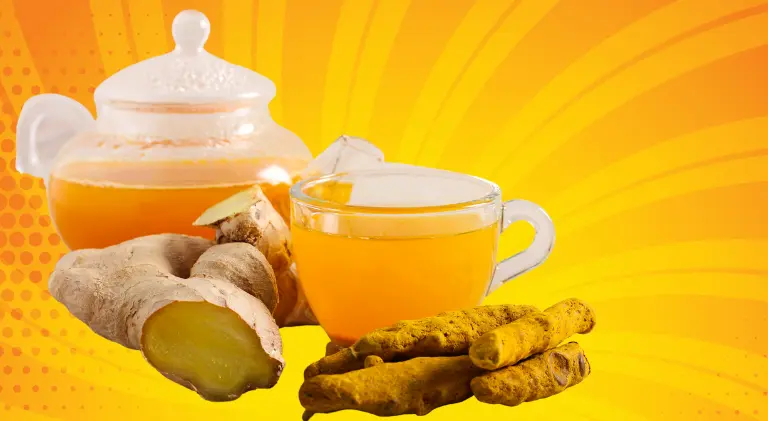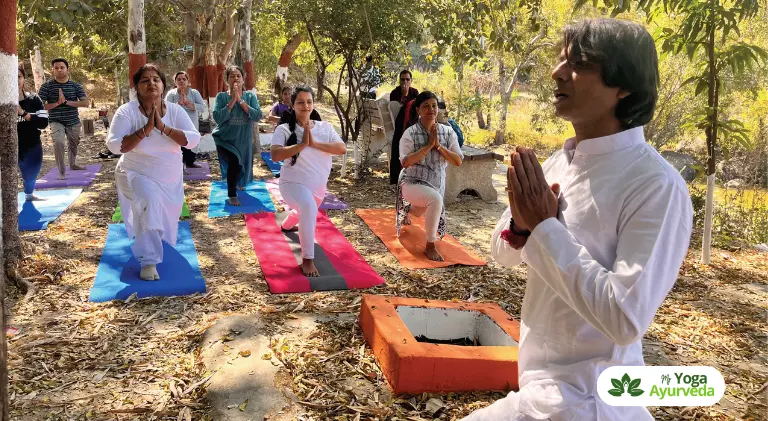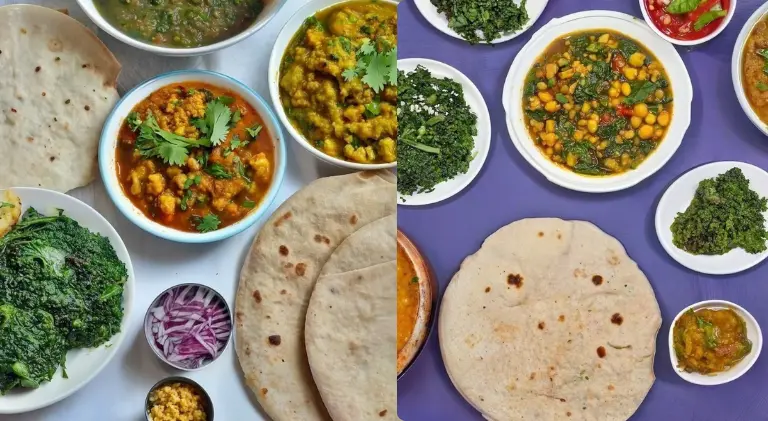
Written by Yoga Mentor Keshav, with facts sourced from Ancient Indian Ayurvedic and Yogic Textbooks, as well as scientific research.
As the crisp air and shorter days of winter approach, it’s crucial to adapt our lifestyle and wellness routines to maintain balance and health. Ayurveda, the ancient Indian system of medicine, provides a treasure trove of wisdom and practices to help us navigate the winter months harmoniously.
In this blog, we’ll delve into seven Ayurvedic secrets for a healthy winter, empowering you to optimize your winter wellness throughout this season.
According to Ayurveda, winter is generally the season of kapha. Winter is a time when the Kapha dosha (dosha of the earth and water elements) is more dominant.
Chakrak Samhita Says : हेमन्तहा शैत्यस्याधिकहा, शुष्कब्रह्मघ्नहा, पित्तघ्नहा, कफवर्धकहा च।
Meaning : Winter is the coldest season, and it is dry, destructive of semen, destructive of bile, and aggravating to Kapha.
Also Read : Three Doshas in Ayurveda
Kapha is associated with heaviness, congestion, and lethargy. However, certain vata-provoking qualities, such as, dry, cold, windy, and clear, are some-times prominent on winter days.
To balance Kapha and stay healthy during the winter months, it is important to follow an Ayurvedic lifestyle.
Here are 7 Ayurvedic Secrets for a Balanced and Healthy Winter
There is no need to get up early. The 05.00 AM rising time is suggested for summer and autumn, it is not necessary in winter. Listen to your body. In Ayurveda, a good night’s sleep is considered crucial for overall health. Try to go to bed early and wake up with the sun. A consistent sleep schedule helps regulate your body’s internal clock and ensures you’re well-rested to face the day’s challenges.
While napping may be acceptable in the summer and autumn (especially for Pitta and Vata individuals, respectively), it is not recommended during the winter because it can increase Kapha dosha, slow down metabolism, and reduce gastric fire.
This warm, invigorating beverage helps to balance Kapha dosha, which is the dosha associated with the earth and water elements.

After waking up in the winter, start your day by drinking 1-2 glasses of warm water. It is especially beneficial to drink ginger and turmeric water. To make this, simply boil a glass of water and add 1/2 inch of grated ginger and 1/2 teaspoon of turmeric powder. Let the mixture steep for 5 minutes, then strain and drink.
When Kapha is in balance, we feel grounded, centered, and resilient. However, in excess, Kapha can lead to feelings of heaviness, sluggishness, and congestion.
Ginger and turmeric are both Ayurvedic herbs with powerful anti-inflammatory and antioxidant properties.
Ginger is also known to boost digestion and circulation, while turmeric helps to promote detoxification and support the immune system.
Studies suggest that Ginger and Turmeric supplementation significantly reduced blood pressure in people with high blood pressure. It is also good for non alcoholic fatty liver. Evidence 1, Evidence 2
Ginger and Turmeric are also helpful to maintain blood sugar levels and good for Type-2 Diabetes. Evidence 1, Evidence 2 .
This ayurvedic drink is also helpful to reduce body weight, waist circumference, and body fat percentage in people with obesity. Evidence 1, Evidence 2
Ginger and Turmeric are helpful to improve metabolic profiles in people with metabolic syndrome.
Take this Three Doshas Quiz and Know your Ayurvedic Prakriti
Drinking ginger and turmeric water in the winter is a simple and effective way to support your overall health and well-being. It is an excellent drink for respiratory health.
It is a good time to move your body in winter to alive your digestive fire and metabolism rolling.
Winter can be a challenging time of year for many people. The cold weather, short days, and lack of sunlight can lead to feelings of lethargy, sadness, and anxiety.
Yoga and meditation can be powerful tools for supporting your physical and mental health during the winter months.
Surya Namaskar (Sun Salutation)
Surya Namaskar is a series of 12 yoga poses called sun salutation. This sequence combines various postures, stretching, and controlled breathing.
You can wake up, shake off any morning stiffness, and build energy with Surya Namaskar.
A sense of inner heat and vitality is provided by Surya Namaskar. It is also a good Cardio exercise, It has a positive impact on cardiovascular & metabolic system and also good for weight loss. Evidence
It can be an alternative for Aerobic Exercise at Home. It is also helpful to increase lung capacity. Evidence

Power Yoga
In the winter, Power Yoga is practiced. It is an ideal dynamic and energizing form of yoga, involving a series of postures and movements. Your muscles are strengthened, and your flexibility is increased by it.
Power Yoga is good for Winters
When Power Yoga is practiced during winter, warmth is generated within your body, especially when it’s cold outside. Feelings of sluggishness that can sometimes accompany the colder weather are prevented.
Take a Free Trial of Yoga Classes Now !
Improved blood circulation and a more invigorated feeling are provided by the flowing movements and deep breathing in Power Yoga.
Pranayama: Breathing Exercises in Winter
Breathing exercises in winter can be a powerful tool for balancing Kapha.
By practicing breathing exercises regularly, you can boost your energy levels, reduce stress, improve circulation, and strengthen your immune system.
Three breathing exercises are beneficial in winter :
Nadi Shodhana or Anulom Vilom Pranayama (Alternate Nostril Breathing): This is a balancing breathing exercise that helps to calm the mind and body. To do Nadi Shodhana, sit in a comfortable position with your spine straight and your hands on your knees.
Close your right nostril with your right thumb and inhale slowly and deeply through your left nostril. Close your left nostril with your right ring finger and exhale slowly and deeply through your right nostril. Continue inhaling and exhaling through alternating nostrils for 5-10 minutes.
Bhastrika (Breathe of Fire) : This is a powerful breathing exercise that helps to warm the body and improve circulation and reduce kapha quicly.
To do Bhastrika, sit in a comfortable position with your spine straight and your hands on your knees.
Begin by inhaling deeply and then exhaling quickly and forcefully through your nose. Continue inhaling and exhaling quickly for 10-20 rounds. If you feel lightheaded, stop and rest.
Surya Bhedi Pranayama (Right Nostril Breathing) : Surya Bhedi Pranayama promotes circulation and heat. To do Surya Bhedi Pranayama, close your left nostril and inhale slowly deeply through the right nostril. Do it for 10-20 rounds.
Kapalabhati (Frontal Brain Cleansing Breath): Kapalbhati helps to warm the body and improve circulation. To do Kapalabhati, sit in a comfortable position with your spine straight and your hands on your knees.
Begin by inhaling deeply and then exhaling quickly and forcefully through your nose, contracting your lower abdomen as you exhale. Continue inhaling and exhaling quickly for 10-20 rounds. If you feel lightheaded, stop and rest.
Sanskrit Sutra: हेमन्ते शीतपवनादिभितः स्नेहना पानं च।
Meaning: Hemante shitapavanadibhitah snehana panam cha. During winter, it’s a good idea to apply oil on your skin to protect it from the cold wind and other harsh weather conditions.
Abhyanga is a traditional Ayurvedic massage that helps to improve circulation, reduce stress, and remove toxins from the body. It is also a very calming and relaxing practice. To do an abhyanga, warm some sesame or almond oil in your hands and massage it into your entire body, from your toes to your heads.
At the end of the day, rub a small amount of sesame oil (Til Tail) on your scalp and on the sole of your feet.
Sanskrit Sutra: “नास्यत्यनु सर्वरोगान्सुखम्” (Naasyati Anu Sarvarogaan Sukham)
Meaning: This sutra states that nasal drops bring comfort and relieve all diseases.
Nasya is an Ayurvedic practice where warm oil is applied to the nasal passages. It helps clear congestion, nourish the nasal membranes, and improve respiratory health, which is particularly beneficial during the winter season.
To perform nasya at home, simply warm a small amount of oil in your hands and then gently apply it to the inside of each nostril. You can use a dropper or a small spoon to apply the oil.
Sesame (Til Taila) or Cow Ghee is good for Nasya.
Sanskrit Sutra: “आहारशुद्धौ सत्त्वशुद्धिः” (Aaharashuddhau Sattvashuddhih)
Meaning: This sutra means “pure food leads to pure thoughts.” Eating seasonally is a fundamental Ayurvedic principle. During winter, focus on warm, nourishing foods like soups, stews, and root vegetables. Warming spices such as ginger, cinnamon, and cumin can also help to boost digestion and circulation.
In winter, it is important to eat foods that are warm and nourishing. This means avoiding raw and cold foods, which can aggravate Kapha.
Charak Samhita Says
स यदा नेन्धनं युक्तं लभते देहजं तदा| रसं हिंसातो वायुः शीतलः शीते प्रकुप्यति|
Meaning : If the body is not provided with enough food, it consumes the increased Agni Rasa (body’s internal fluids). Vata, which has a cold (cooling) quality, gets worse in this cold weather.
Diet Plan for Winter :
Breakfast : For a good winter breakfast, have some Oatmeal, Cornmeal, Barley soup, Kitchari, Quinoa Dosa, Millet Upma, Dal Idli or poha (cooked rice flakes). About an hour later, drink tea made of these herbs.
Dry Ginger (Sonth) (½ spoon)
Cinamon (¼ spoon)
Clove (1 clove).
You have to boil these herbs in a cup of hot water for five minutes, then enjoy the tea. This will enhance warmth and pitta, boost circulation, and clear mucus from your system. However, if you’re dealing with an ulcer, it’s best to avoid this tea as it could be too heating.
Lunch & Dinner :
For lunch, eat kapha-soothing food but not food that is vata-aggravating. Multi Grain Roti, Steamed Vegetables, Palak, Bathua, Chana Bhaji, Basmati unpolished Rice.

Here are some ideas :
For a Kapha-soothing dinner that avoids Vata-aggravating foods, consider the following options:
Multi-Grain Roti or Whole Wheat Roti: Opt for whole grain roti, which is grounding and less likely to aggravate Vata. You can also try roti made from a mix of grains like jowar, bajra, and whole wheat for added variety.
Steamed Vegetables: Choose a variety of seasonal, non-starchy vegetables for your main dish. Steaming vegetables retains their natural moisture and flavor without making them too drying for Vata.
Leafy Greens (Palak and Bathua): Prepare a light sauté or stir-fry of leafy greens like spinach (palak) and bathua. Use minimal oil and warming spices to enhance the taste.
Chana Bhaji (Chickpea Curry): A chickpea (chana) curry with warming spices like ginger, turmeric, and cumin is both nourishing and soothing for Kapha. Ensure the curry is not overly creamy to avoid excess heaviness.
Vegetable Soup or Stew: Prepare a light and warming vegetable soup or stew using seasonal vegetables and spices like ginger, garlic, black pepper, and turmeric. This will help balance Kapha without overly drying Vata.
Lentil Dal (Masoor Dal) with Rice or Quinoa: Enjoy a comforting lentil dal with your choice of rice or quinoa. Opt for well-cooked lentils seasoned with gentle spices like cumin, coriander, and asafoetida to avoid Vata imbalance.
Vegetable Stir-Fry with Bajra Roti: A vegetable stir-fry with a variety of colorful veggies, ginger, garlic, coriander seeds (dhaniya) , served with Bajra Roti, makes for a balanced and satisfying dinner.
Gobhi (Cauliflower) with Black Pepper, Turmeric, Garlic and Cumin: Cook cauliflower (gobhi) with warming spices like black pepper, turmeric, garlic and cumin. These spices help counteract Kapha tendencies. Serve with Jau Roti.
Sautéed Chickpeas (Matar): Sauté chickpeas with ginger and turmeric for a light and nutritious dinner option. It’s both Kapha-soothing and Vata-friendly when prepared with care.
The best herbs for winter are Pipali, Ginger, Punarnarva, Black Pepper, Licorice (Mulethi) and Kutki.
Trikatu is also an excellent ayurvedic preparation for winters.
Also Read : Trikatu for Winters
Ashwagandha is an excellent ayurvedic herb for vitality, stress, depression, anxiety, insomnia. It balances Vata and promotes sexual health. Evidence 1 It is also a good herb for memory Evidence 2
You can also use the herbal tonic Chyawanprash in winter.
Chyawanprash is an Ayurvedic herbal supplement that is made with a blend of over 50 nutrient-rich herbs and minerals.
It is believed to restore the body’s natural energy reserves, improve strength and vitality, and slow down the aging process.
Amla, the main ingredient in Chyawanprash, is the world’s richest source of vitamin C, which is essential for a healthy immune system. Evidence
Incorporating these Ayurvedic secrets in winter can help you maintain balance and well-being during the colder months.
Ayurveda recognizes the dominance of the Kapha dosha during winter, characterized by heaviness and congestion.
To counteract these effects, Ayurvedic practices like proper sleep, drinking ginger and turmeric water, yoga and meditation, self-massage (Abhyanga), nasal oil application (Nasya), and a warm, nourishing diet can be beneficial.
Additionally, the use of specific herbs, such as Ashwagandha and Chyawanprash, can further support your health during this season.
What is the significance of the Kapha dosha in winter?
Winter is associated with the dominance of the Kapha dosha, characterized by qualities of heaviness, congestion, and lethargy. Balancing Kapha during this season is essential for overall well-being.
How can I improve my sleep during winter?
In Ayurveda, it’s important to get a good night’s sleep. To do so, aim for a consistent sleep schedule, going to bed early and waking up with the sun. Avoid napping during the day, as it can increase Kapha dosha.
What is the Ayurvedic significance of drinking ginger and turmeric water in winter?
Ginger and turmeric water helps balance Kapha dosha and provides numerous health benefits, including anti-inflammatory and antioxidant properties. It can also support digestion, circulation, and immune health.
What yoga and meditation practices are recommended for winter?
Surya Namaskar (Sun Salutation), Power Yoga, and breathing exercises like Nadi Shodhana and Bhastrika can help improve physical and mental health during winter.
How can I incorporate self-massage (Abhyanga) into my winter routine?
Abhyanga involves massaging warm sesame or almond oil into your entire body to improve circulation, reduce stress, and remove toxins. It’s a calming and relaxing practice.
What is Nasya, and how can I use it during winter?
Nasya is the practice of applying warm oil to the nasal passages. It helps clear congestion, nourish nasal membranes, and improve respiratory health. Sesame oil or cow ghee can be used for Nasya.
What foods should I eat during winter according to Ayurveda?
Ayurveda recommends warm, nourishing foods like soups, stews, root vegetables, and warming spices (e.g., ginger, cinnamon, cumin). Avoid raw and cold foods that can aggravate Kapha.
What are some Ayurvedic herbs that can be used in winter?
Herbs like Pipali, Ginger, Punarnarva, Black Pepper, Licorice (Mulethi), Kutki, and Ashwagandha can be beneficial for maintaining health during the winter season.
Chyawanprash, a herbal supplement, is also recommended for its immune-boosting properties.
Have other questions ? send us your questions Here !


